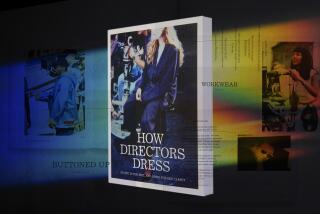Marching Toward an Americana Trend
- Share via
For a nation at war, expressing patriotism is as natural as singing “America the Beautiful” or dressing in Tommy Hilfiger red, white and blues. It is fashionable, as well as meaningful, to drape flags over windows and pin them on lapels. But now Old Glory is appearing on sofa cushions and shower curtains.
It would be easy to run with a flag-waving trend, and some manufacturers have. Not every great notion translates as decor. The flag is a powerful graphic symbol. Less of it can mean a great deal more.
Michelle Lamb, a forecaster of home-furnishing trends, has been telling clients that “we will have an Americana trend.” But she doesn’t believe that means upholstering a flag on the sofa.
The trend in furnishings and fabrics was coming to the fore before flag waving broke out in earnest.
At the fall furniture trade show in High Point, N.C., Lamb was surprised to find a red, white and blue sofa with stars. Ottomans and pillows wore stars and stripes.
A quick trip to a fabric store turned up a Ralph Lauren cotton with red flowers against a blue-and-white striped background. It came frighteningly close to the vision Lamb has in her mind’s eye: “red strawberries with a white halo on a blue background.”
If that seems like spun sugar, Lamb means it to sound sweet. She’s reaching back to World War II for “a nice little 1940s twist.” Picture the Andrews Sisters delivering “Don’t Sit Under the Apple Tree.”
Lamb’s Eden Prairie, Minn., company produces the Trend Curve report for the home-furnishing industry. Her inspiration comes straight from the news: War bonds are back and, she reasons, victory gardens may not be far behind. Instead of stars and stripes, she figures fruits and vegetables could become welcome symbols of patriotism.
Much more interesting in light of geopolitics was the lamp on display at a Calico Corners fabric shop: a camel sitting beneath a rattan shade. The accessory, which was not for sale, sits amid a worldly display: faintly Moroccan beaded pillows, swirling paisley prints and ceremonial elephants parading across the cotton fabric of an upholstered chair.
Decorating sophisticates have been traveling the Silk Road and visiting the souk for three or four years, according to store manager Sam Wilson. Long before graphics on the nightly news focused attention on distant regions, Americans were upholstering furniture with designs straight out of disputed Kashmir and plumping pillows decorated with Middle Eastern detailing. For the recent National Symphony Orchestra decorator show house, students from Montgomery College in Maryland designed a Middle East-inspired room they called “The Sheik Spot.” House Beautiful magazine has just featured Kashmir and Punjab paisleys on wing chairs.
Lamb believes Mideast accessories will become style victims. “They’re beautiful, historical and sophisticated,” she says. “But right now they don’t create the comfort level for consumers that they’re going to want. We will return to them, just not right now.”
In her view, the elephant prints and paisleys appeal to customers seeking to connect with some distant era of British colonial rule on the Indian subcontinent. The notion of 1940s fruits and vegetables strikes her as too dated for those customers. On the other hand, it would be hard to argue that colonialism hadn’t outlived its day.
Matters of taste have often sparked controversy. Trends come and go, usually in four-year cycles. After waves of English, French, Italian and Swedish country, furniture inspired by Pennsylvania stone houses or the Hickory Chair Co. of Connecticut were beginning to look fresh again. Now, after the attack, Americana may also be comforting.
Says Lamb, “We were marching toward an Americana trend anyway. It has been out of vogue for 20 years. It was time for it to come back.”
Red may or may not turn up as berries. But blue and white will be present in denim, sometimes in stripes. In this pro-nostalgia view, anything goes as long as it looks the way “Boogie-Woogie Bugle Boy” sounds.
The success of any trend depends on how willing consumers are to spend. Right now the home-furnishing industry is hoping Americans will continue to spruce up home and hearth, with or without flag decor.
People who are fearful of travel are likely to spend more time around the house. More time at home could revive remodeling activity, which softened after the collapse of the New Economy.
In recent years, remodeling dollars have shifted from DIY (do it yourself) to BIY (buy it yourself and get someone else to install). Lamb thinks DIY projects are about to regain status. Anyone who needs a justification for hunkering down can just say, “Sorry, but I have this project at home.”
Real Simple magazine is already humming that tune. Its November cover story focused on “Making Time for What Matters.” Along with ideas for de-stressing at the holidays, there are eight lessons in how to “Be Your Own Handyman.” No. 3 is “how to make a martini the way a man does.”
Bring on the bugle girls.
More to Read
Sign up for Essential California
The most important California stories and recommendations in your inbox every morning.
You may occasionally receive promotional content from the Los Angeles Times.










